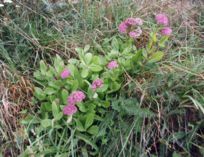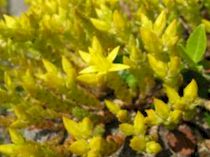|

House Leek |
The House Leek (Sempervivum tectorum), or "never dying" flower of our cottage roofs, which is commonly known also as Stone-crop, grows plentifully on walls and the tops of small buildings throughout Great Britain, in all country districts. It is distinguished by its compact rose-shaped arrangement of seagreen succulent leaves lying sessile in a somewhat flattened manner, and by its popularity among country folk on account of these bland juicy leaves, and its reputed
protective virtues. It possesses a remarkable tenacity of life, quem sempervivam dicunt quoniam omni tempore viret, this being in allusion to its prolonged vitality; |
for which reason it is likewise called Ayegreen, and Sengreen (semper, green).
History relates that a botanist tried hard for eighteen months to dry a plant of the House Leek for his herbarium, but failed in this object. He afterwards restored it to its first site when it grew again as if nothing had interfered with its ordinary life.
The plant was dedicated of old to Thor, or Jupiter, and sometimes to the Devil. It bore the titles of Thor's beard, Jupiter's eye, Joubarb, and Jupiter's beard, from its massive inflorescence which resembles the sculptured beard of Jove; though a more recent designation is St. George's beard.
"Quem sempervivam dicunt quoniam viret omni Tempore--'Barba Jovis' vulgari more vocatur, Esse refert similem predictoe Plinius istam." Macer.
The Romans took great pleasure in the House Leek, and grew it in vases set before the windows of their houses. They termed it "Buphthalmon", "Zoophthalmon", and "Stergethron", as one of the love medicines; it being further called "Hypogeson", from growing under the eaves; likewise "Ambrosia" and "Ameramnos". The plant is indigenous to the Greek Islands, being sometimes spoken of as "Imbreke" and "Home Wort."
It has been largely planted about the roofs of small houses throughout the country, particularly in Scotland, because supposed to guard against lightning and thunderstorms; likewise as protective against the enchantments of sorcerers; and, in a more utilitarian spirit, as preservative against decay. Hence the House Leek is known as Thunderbeard, and in Germany "Donnersbart" or "Donderbloem", from "Jupiter the thunderer."
The English name House Leek denotes leac (Anglo-Saxon) a plant growing on the house; and another appellation of its genus, sedum, comes from the Latin sedare, to soothe, and subdue inflammations, etc.
The thick leaves contain an abundant acidulous astringent juice, which is mucilaginous, and affords malic acid, identical with that of the Apple. This juice, in a dose of from one to three drams, has proved useful in dysentery, and in some convulsive diseases. Galen extolled it as a capital application for erysipelas and shingles. Dioscorides praised it for weak and inflamed eyes, but in large doses it is emetic and purgative.
In rural districts the bruised leaves of the fresh plant or its juice are often applied to burns, scalds, contusions, and sore legs, or to scrofulous ulcers; as likewise for chronic skin diseases, and enlarged or cancerous lymphatic glands. By the Dutch the leaves are cultivated with a dietetic purpose for mixing in their salads.
With honey the juice assuages the soreness and ulcerated condition within the mouth in thrush. Gerard says: "The juice being gently rubbed on any place stung by nettles, or bees, or bitten by any venomous creature, doth presently take away the pain. Being applied to the temples and forehead it easeth also the headache and distempered heat of the brain through want of sleep."
The juice, moreover, is excellently helpful for curing corns and warts, if applied from day to day after they have been scraped. As Parkinson teaches, "the juice takes away corns from the toes and feet if they be bathed therewith every day, and at night emplastered as it were with the skin of the same House Leek."
The plant may be readily made to cover all the roof of a building by sticking on the offsets with a little moist earth, or cow dung. It bears purple flowers, and its leaves are fringed at their edges, being succulent and pulpy. Thus the erect gay-looking blossoms, in contrast to the light green foliage arranged in the form of full blown double roses, lend a picturesque appearance to the roof of even a cow-byre, or a hovel.
The House Leek (Sedum majus), and the Persicaria Water-pepper (Arsmart), if their juices be boiled together, will cure a diarrhea, however obstinate, or inveterate. The famous empirical anti-Canceroso nostrum of Count Mattaei is authoritatively said to consist of the "Sedum acre" (Betony stone-crop), the "Sempervivum tectorum" (House Leek), "Sedum telephium" (Livelong), the "Matricaria" (Feverfew), and the "Nasturtium Sisymbrium" (Water-cress).
|

Sedum Telephium |
The "Sedum Telephium" (Livelong, or Orpine), called also Roseroot and Midsummer Men, is the largest British species of Stone-crop. Being a plant of augury its leaves are laid out in pairs on St. John's Eve, these being named after courting couples. When the leaves are freshly assorted those which keep together promise well for their namesakes, and those which fall apart, the reverse.
The special virtues of this "Sedum" are supposed to have been discovered by Telephus, the son of Hercules. Napoleon, at St. Helena, was aware of |
its anti-cancerous reputation, which was firmly believed in Corsica.
The plant contains lime, sulphur, ammonia, and (perhaps) mercury. It remains long alive when hung up in a room. The designation Orpine has become perversely applied to this plant which bears pink blossoms, the word having been derived from "Orpin", gold pigment, a yellow sulphuret of the metal arsenic, and it should appertain exclusively to yellow flowers. The Livelong "Sedum" was formerly named Life Everlasting. It serves to keep away moths.
Doctors have found that the expulsive vomiting provoked by doses of the "Sedum acre" (Betony stone-crop), will serve in diphtheria to remove such false membrane clinging in patches to the throat and tonsils, as threatens suffocation: and after this release afforded by copious vomiting, the diphtheritic foci are prevented from forming again.
|

Sedum Acre |
The Sedum Acre (or Biting Stone-crop) is also named Pepper crop, being a cyme, or head of flowers, which furnishes a pungent taste like that of pepper. This further bears the names of Ginger (in Norfolk), Jack of the Buttery, Gold Dust, Creeping Tom, Wall Pepper, Pricket or Prick Madam, Gold Chain, and Biting Mouse Tail. It was formerly said "the savages of Caledonia use this plant for removing the sloughs
of cancer."
The herb serves admirably to make a gargle for scurvy of the gums, and a lotion for scrofulous, or syphilitic ulcers. The leaves are thick and very |
acrid, being crowded together. This and the Sedums album and reflexum were ingredients in a famous worm-expelling medicine, or theriac (treacle), which conferred the title "Jack of the Buttery," as a corruption of "Bot. theriaque."
The several Stone-crops are so named from "crop", a top, or bunch of flowers, these plants being found chiefly in tufts upon walls or roofs. From their close growth originally on their native rocks they have acquired the generic title of "Sedum", from sedere (to sit).
Herb Simples
The Primitive Simplers presented here show the way of life in other generations, it is not suggested or recommended trying them yourself. |
|
Garden
Herbs
Home
History of Herbs
Herb Gardening
Herbs for Beginners
Drying & Preserving Herbs
Indoor Herb Gardening
Herb Garden
Hints & Tips
Herbal
Cooking
Herb Chart
Using Herbs
Culinary Herbs
Herb
Oil and Vinegar
Herb Teas
Herb Candy
Herb Jelly
Herb Simples
Preface
Introduction
Alphabetical Listing

Trade
Recipes Online
Share your Recipes with others!!
|




